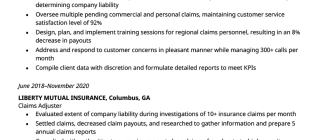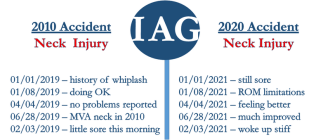
The Future of Insurance Adjusting: Trends to Watch.
Insurance adjusting has always been a crucial aspect of the insurance industry, ensuring that policyholders receive fair compensation for their claims. However, as technology continues to advance at a rapid pace, the role of insurance adjusting is undergoing a significant transformation. The future of insurance adjusting promises to be more efficient, accurate, and customer-centric, thanks to emerging trends.
One of the key trends shaping the future of insurance adjusting is the use of data analytics. With the exponential growth of digital data, insurance companies are now able to analyze vast amounts of information to make more informed decisions. By harnessing data analytics, insurance adjusters can quickly assess the validity of a claim and determine the appropriate compensation, reducing the time and resources required for manual investigations.
Another important trend is the integration of artificial intelligence (AI) and machine learning (ML) into insurance adjusting processes. AI-powered algorithms can analyze historical claim data to identify patterns and anomalies, helping insurance adjusters detect fraudulent claims. ML models can also be used to automate routine tasks, allowing adjusters to focus on complex and high-value claims. This combination of AI and ML has the potential to revolutionize insurance adjusting, making it more accurate, efficient, and cost-effective.
Additionally, the future of insurance adjusting will also see a greater emphasis on customer experience. As insurance becomes more personalized, policyholders expect a seamless and transparent claims process. Adjusters will need to leverage technology to provide real-time updates, online claim filing, and virtual assessment tools to enhance customer satisfaction. By embracing these customer-centric trends, insurance companies can differentiate themselves in a competitive marketplace and build lasting relationships with their policyholders.
In conclusion, the future of insurance adjusting looks promising and full of potential. From data analytics and AI to enhanced customer experience, insurance adjusters are embracing the latest trends to transform their industry. By staying on top of these emerging technologies and focusing on customer needs, insurance companies can ensure a smoother claims process and a brighter future for insurance adjusting as a whole.
Data-Driven Decision Making
In the rapidly evolving landscape of insurance, data-driven decision making is becoming an increasingly important trend to watch. With advancements in technology and the availability of vast amounts of data, insurance companies are now able to make more informed decisions about their policies, claims, and overall business strategies.
By analyzing large sets of data, insurers can identify patterns, trends, and correlations that may have previously gone unnoticed. This allows them to better understand risks, anticipate potential claims, and adjust their policies accordingly. For example, by analyzing demographic data and historical claim statistics, an insurance company may determine that certain groups of individuals are more likely to file claims, and adjust their premiums accordingly.
Furthermore, data-driven decision making enables insurance adjusters to streamline their processes and improve efficiency. By leveraging data analytics platforms and artificial intelligence, adjusters can quickly process and assess claims, reducing the need for manual inspection and investigation. This not only speeds up the entire claims process but also reduces costs and improves customer satisfaction.
Another benefit of data-driven decision making is its ability to help insurers detect and prevent fraud. By analyzing patterns and anomalies in claims data, insurers can identify potential fraudulent activities and take the necessary steps to investigate and resolve these cases. This not only helps save money, but also protects the integrity of the insurance industry as a whole.
As the future of insurance continues to unfold, it is clear that data-driven decision making will play a crucial role in shaping the industry. Insurance companies that embrace this trend and invest in data analytics capabilities will likely gain a competitive advantage in the marketplace. By leveraging the power of data, insurers can make more accurate predictions, improve their underwriting processes, and enhance the overall customer experience.
| insurance | digital transformation in insurance |
| trends | AI in insurance |
| watch | automation in insurance |
| future | usage-based insurance |
Artificial Intelligence and Machine Learning
One of the most important trends in the future of insurance adjusting is the integration of artificial intelligence (AI) and machine learning (ML) technologies. These advancements have the potential to completely transform the way insurance claims are processed and resolved.
AI and ML algorithms can analyze large amounts of data and identify patterns and trends that humans may not be able to detect. This can significantly improve the accuracy and efficiency of the claims handling process, reducing the time it takes to assess and settle claims.
Insurance companies can use AI and ML to automate repetitive tasks, such as data entry and analysis, freeing up adjusters to focus on more complex and value-added tasks. This can lead to increased productivity and better customer service.
Furthermore, with the help of AI and ML, insurance adjusters can make more accurate predictions about risk and potential losses, allowing insurers to better tailor their policies and pricing. This can result in a more personalized and fair insurance experience for policyholders.
However, it is important to note that while AI and ML technologies have the potential to revolutionize the insurance industry, they are not without their challenges. Issues such as data privacy, bias in algorithms, and the need for human oversight and decision-making must be carefully addressed.
In conclusion, the integration of artificial intelligence and machine learning is a key trend to watch in the future of insurance adjusting. These technologies have the potential to improve the accuracy, efficiency, and personalization of the claims handling process, benefiting both insurers and policyholders.
Internet of Things
With the rapid advancement of technology, the insurance industry is embracing the Internet of Things (IoT) as a means to revolutionize the way insurance adjusting is done. IoT refers to the network of interconnected physical devices, vehicles, buildings, and other objects embedded with sensors, software, and connectivity to enable the exchange of data.
In the realm of insurance adjusting, IoT allows for real-time monitoring and data collection, providing insurers with valuable insights into their customers’ behaviors and risks. This data can be used to inform pricing strategies, adjust premiums, and optimize the claims process.
One of the key trends in the future of insurance adjusting is the use of IoT-enabled devices to prevent and mitigate risks. For example, sensors installed in vehicles can provide continuous feedback on driving behaviors, allowing insurers to reward safe drivers with lower premiums. Similarly, smart sensors in buildings can detect potential hazards such as leaks or fire risks, alerting property owners and insurers before major damage occurs.
The adoption of IoT in insurance adjusting also facilitates faster and more accurate claims processing. IoT devices can automatically capture data related to accidents or property damages, reducing the need for manual evaluations. Claims adjusters can access this data in real-time, leading to quicker resolution and improved customer satisfaction.
| Real-time monitoring and data collection |
| Improved risk assessment and pricing strategies |
| Prevention and mitigation of risks |
| Faster and more accurate claims processing |
Digital Transformation
One of the key trends to watch in the future of insurance adjusting is the digital transformation of the industry. With the advancement of technology and the widespread use of smartphones, insurance companies are embracing digital solutions to streamline their processes and improve efficiency.
Through digital transformation, insurance adjusters are able to collect and analyze data more efficiently, leading to better risk assessment and more accurate claim settlements. With the help of artificial intelligence, machine learning, and data analytics, insurers are able to quickly assess damages, estimate costs, and process claims in a timely manner.
Additionally, digital transformation allows for better communication between insurance adjusters and policyholders. Through digital platforms and mobile apps, policyholders can easily submit claims, track the progress of their claims, and receive regular updates. This improves customer experience and satisfaction, as well as reduces operational costs for insurance companies.
The future of insurance adjusting is undoubtedly being shaped by technology, and the digital transformation of the industry is a trend that will continue to evolve. Insurance companies that embrace these digital solutions will be better equipped to meet the changing needs of their customers and stay competitive in the market.
Customer Centricity
In the future of insurance adjusting, customer centricity is a key trend to watch. With advancements in technology and data analytics, insurance companies are able to gather more information about their customers and their needs. This allows them to provide personalized and tailored solutions that meet the specific requirements of each individual customer.
Customer centricity also involves improving the claims process to make it more efficient and customer-friendly. This can include using digital tools to streamline the claims process, providing clear and transparent communication with customers, and offering self-service options for filing and tracking claims.
By putting the customer at the center of the adjusting process, insurance companies can enhance customer satisfaction and loyalty. This can result in higher retention rates and increased referrals, ultimately leading to business growth.
Additionally, customer centricity can help insurance companies in identifying and addressing potential risks and gaps in their coverage. By understanding the unique needs and concerns of their customers, insurers can develop new products and services that provide comprehensive protection.
In conclusion, customer centricity is a crucial trend in the future of insurance adjusting. By leveraging technology and data, insurers can provide personalized solutions, improve the claims process, enhance customer satisfaction, and develop new products to meet the evolving needs of their customers.
Automation and Efficiency
One of the key trends to watch in the future of insurance is the increasing automation and efficiency in the adjusting process. As technology continues to advance, insurance companies are finding ways to streamline their operations and improve the overall customer experience.
One way insurance companies are automating their adjusting process is through the use of artificial intelligence and machine learning. These technologies can analyze large amounts of data and make predictions based on patterns and trends. This allows adjusters to quickly assess claims and make more accurate decisions.

Another trend in automation is the use of robotic process automation (RPA) to handle repetitive and time-consuming tasks. This allows adjusters to focus on more complex and strategic aspects of the adjusting process, while the robots handle the mundane work. This improves efficiency and reduces the risk of errors.
Additionally, the use of mobile technology is making the adjusting process more efficient. Adjusters can now access claims information on-the-go, allowing them to respond to customer inquiries and process claims faster. This helps reduce the time it takes to settle a claim and improves customer satisfaction.
| 1. Faster claims processing times |
| 2. Improved accuracy in claim assessments |
| 3. Reduced risk of errors |
| 4. Enhanced customer experience |
Blockchain Technology
As we watch the insurance adjusting field evolve and adapt to new trends, one technology that is gaining significant attention is blockchain. Blockchain technology has the potential to revolutionize the insurance industry’s processes by improving transparency, security, and efficiency.
Blockchain is a decentralized digital ledger that records transactions across multiple computers. Each transaction is grouped together in a “block” and added to a “chain” of previous transactions, creating an immutable record. This technology eliminates the need for a central authority, such as a bank or government, to verify and store transaction data.
In the insurance industry, blockchain can be used to improve efficiency in claims processing, policy underwriting, and fraud prevention. By using smart contracts, insurance companies can automate the claims settlement process, reducing the time and resources required for manual processing. Additionally, blockchain can provide a tamper-proof record of policy details, making it easier to verify policy information and detect fraudulent activity.
Another area where blockchain technology can have a significant impact is data security. With blockchain, sensitive customer information can be encrypted, stored securely, and accessed only with the owner’s permission. This can help prevent data breaches and protect customer privacy.
Furthermore, blockchain can improve transparency within the insurance industry. By providing a transparent and auditable record of transactions, blockchain can enhance trust between insurers, policyholders, and other stakeholders. This increased transparency can lead to more accurate risk assessment and fairer pricing for policyholders.
Overall, blockchain technology has the potential to transform the insurance adjusting field by streamlining processes, enhancing security, and increasing transparency. As this technology continues to mature and gain wider adoption, it will be important for insurance adjusters to stay informed and adapt to these emerging trends.
Cybersecurity and Data Privacy
In the future of insurance adjusting, one of the key trends to watch is the increasing importance of cybersecurity and data privacy. With the rising threat of cyber attacks and the potential for sensitive customer information to be compromised, insurance companies are taking steps to protect their data and ensure the privacy of their customers.
Cybersecurity measures such as firewalls, encryption, and multi-factor authentication are being implemented to prevent unauthorized access to insurance company systems. This helps to safeguard sensitive customer information, such as personal and financial data, from falling into the wrong hands.
Additionally, insurance companies are investing in advanced technology and artificial intelligence to detect and prevent cyber attacks in real-time. Machine learning algorithms can analyze vast amounts of data to identify patterns and anomalies that may indicate a potential security breach.
Data privacy regulations, such as the European Union’s General Data Protection Regulation (GDPR), are also influencing the insurance industry. Companies are now required to obtain explicit consent from customers for the collection and use of their personal data. They must also provide clear information on how data is stored, processed, and protected.
Insurance adjusters are also being trained on the importance of cybersecurity and data privacy. They are taught to handle customer information with care and to follow security protocols to prevent breaches. This includes practices such as securely storing customer documents, using secure communication channels, and properly disposing of sensitive information.
Overall, cybersecurity and data privacy will continue to be important trends to watch in the future of insurance adjusting. As technology advances and the threat landscape evolves, insurance companies must remain vigilant in their efforts to protect customer data and ensure the privacy of their policyholders.
Remote Claims Processing
As technology continues to advance, one of the trends to watch in the future of insurance adjusting is remote claims processing. This method allows insurance adjusters to process claims from a remote location, eliminating the need for them to physically inspect the damage on-site.
With remote claims processing, adjusters can review photos and videos of the damage submitted by the policyholder, as well as any necessary documentation. They can then assess the extent of the damage and determine the appropriate compensation without needing to visit the location in person.
This trend offers several advantages. First, it increases efficiency and saves time for both the adjuster and the policyholder. By eliminating the need for travel, adjusters can process claims more quickly, resulting in faster payouts for policyholders.
Second, remote claims processing reduces costs for insurance companies. Travel expenses, such as transportation and accommodation, are no longer necessary, resulting in significant savings for insurers. This allows companies to allocate their resources more effectively and provide more competitive rates to policyholders.
Furthermore, remote claims processing also improves safety, especially in situations where the damage is severe or hazardous. Adjusters can assess the damage remotely, without putting themselves at risk. This is particularly beneficial in cases of natural disasters or accidents where the location may be unsafe or inaccessible.
In conclusion, remote claims processing is a trend to watch in the future of insurance adjusting. With advancements in technology, this method offers increased efficiency, cost savings, and improved safety for both insurance adjusters and policyholders. As the industry continues to adapt and evolve, remote claims processing will likely become more common, revolutionizing the way insurance claims are handled.
Mobile Claims Management
In the future of insurance adjusting, an emerging trend to watch is the use of mobile claims management. With advancements in technology and the widespread use of mobile devices, insurance companies are starting to leverage these tools to improve the efficiency and accuracy of the claims process.
Mobile claims management allows adjusters to access and update claim information in real-time, right from their mobile devices. This means that adjusters can receive new claim assignments, gather necessary details, and submit reports all while on the go, eliminating the need for traditional, paper-based processes.
By using mobile devices, insurance adjusters can streamline the claims process and reduce the time it takes to settle claims. They can easily capture photos and videos of the damage, record statements from policyholders and witnesses, and upload all relevant information directly into the claims management system.
Furthermore, mobile claims management offers benefits such as improved communication and collaboration between adjusters and other parties involved in the process. Adjusters can quickly and easily share information with colleagues, supervisors, and even policyholders, leading to faster and more accurate claim resolutions.
Overall, mobile claims management is a trend that will shape the future of insurance adjusting. It enables adjusters to work more efficiently, improves the accuracy of claim data, and enhances the overall customer experience. As technology continues to advance, we can expect to see even more innovations in this area, further transforming the way insurance claims are handled.
Predictive Analytics
Insurance adjusting is an essential part of the insurance industry, ensuring that claims are accurately assessed and resolved. However, with the ever-increasing volume of data that insurers have access to, traditional manual methods of adjusting are becoming less efficient and reliable. This is where predictive analytics comes in.
Predictive analytics is a powerful tool that enables insurers to analyze large amounts of data to forecast future events and outcomes. By using historical data, statistical algorithms, and machine learning techniques, insurers can identify patterns, trends, and correlations that may not be immediately apparent to human adjusters.
By leveraging predictive analytics, insurers can make more informed decisions and improve the efficiency and accuracy of the claims adjusting process. Here are some key trends to watch in the future of insurance adjusting:
1. Data-driven decision-making: Predictive analytics allows insurers to make data-driven decisions based on objective analysis rather than subjective judgment. By incorporating real-time data and advanced modeling techniques, insurers can identify potential fraud, assess risk, and determine the most appropriate claim handling approach.
2. Automated claims processing: With the help of predictive analytics, insurers can automate many of the routine tasks involved in claims processing. This can help reduce the administrative burden and allow adjusters to focus on more complex and value-added tasks such as investigating suspicious claims or negotiating settlements.
3. Improved customer experience: Predictive analytics can help insurers personalize the claims experience for their customers. By analyzing customer data, insurers can anticipate customer needs, provide proactive support, and offer tailored solutions. This can lead to higher customer satisfaction and retention rates.
4. Fraud detection: Insurance fraud is a significant issue for insurers, costing billions of dollars each year. Predictive analytics can help identify fraudulent claims by analyzing patterns and inconsistencies in data. By detecting fraud early on, insurers can save money and protect their bottom line.
In conclusion, predictive analytics is a game-changer for insurance adjusting. It enables insurers to harness the power of data to make more informed decisions, automate processes, improve the customer experience, and detect fraud. As technology continues to advance, the role of predictive analytics in insurance adjusting will only grow, making it a trend to watch closely.
Telematics
Telematics is one of the emerging trends in the future of insurance adjusting. It involves the use of technology to monitor and collect data on driving behavior. This data is then used by insurance companies to determine insurance premiums and assess claims.
With telematics, insurance adjusters can gather real-time information about how a person drives, including their speed, acceleration, and braking habits. This information allows insurers to better understand the risk associated with each individual driver and adjust premiums accordingly.
The future of insurance adjusting will likely see an increase in the use of telematics as technology continues to advance. Advancements in sensors and mobile technology will make it easier and more cost-effective for insurers to collect and analyze driving data.
Telematics has the potential to revolutionize the insurance industry by allowing insurers to offer more personalized policies and pricing. It also has the potential to improve customer experience by allowing for faster and more accurate claims processing.
However, the use of telematics also raises privacy concerns as it involves the collection and use of personal data. Insurance adjusters will need to ensure proper data security measures are in place to protect this sensitive information.
In conclusion, telematics is a significant trend to watch in the future of insurance adjusting. Its ability to collect and analyze driving data has the potential to revolutionize the insurance industry and improve customer experience. However, proper measures must be taken to address privacy concerns and protect personal data.
Climate Change and Natural Disasters
Climate change is one of the most pressing issues of our time, and its impact on natural disasters is a crucial aspect of insurance adjusting in the future. As the climate continues to warm, we can expect to see an increase in the frequency and severity of natural disasters such as hurricanes, wildfires, and floods.
Insurers will need to adapt to these changing conditions by developing new strategies and tools for assessing and mitigating risk. For example, advanced predictive modeling and data analysis can help insurers better understand the potential impact of climate change on different regions and adjust their policies accordingly.
Additionally, insurance adjusting will play a critical role in helping communities recover from natural disasters. As extreme weather events become more common, the need for efficient and accurate claims processing will be paramount. Insurers will need to invest in technology and systems that can streamline the claims process and provide timely assistance to policyholders in times of crisis.
Furthermore, insurance adjusting will also need to consider the long-term effects of climate change on property values and insurance premiums. As certain areas become more prone to natural disasters, insurers may need to adjust their rates to reflect the increased risk. This could have significant implications for homeowners and businesses in these vulnerable regions.
In conclusion, climate change is an important trend that will shape the future of insurance adjusting. Insurers must adapt to the changing climate and develop innovative solutions to assess and mitigate risk. By doing so, they can provide the necessary support to policyholders and help communities recover from the increasing number of natural disasters.
undefined
What are some of the key trends in insurance adjusting?
Some of the key trends in insurance adjusting include the use of technology to streamline claims processes, the increasing role of data analytics in assessing risk and adjusting claims, the rise of automated and remote adjusting, and the shift towards a customer-centric approach.
How is technology being used to improve insurance adjusting?
Technology is being used in various ways to improve insurance adjusting. For example, mobile apps and online platforms are being utilized to allow policyholders to file claims and submit documentation easily. Drones and satellite imagery are also being used to assess property damage in a faster and more efficient way. Additionally, AI and machine learning algorithms are being employed to analyze data and provide insights for claim settlement.
What are the benefits of automated and remote adjusting?
Automated and remote adjusting offers several benefits. First, it increases efficiency by allowing adjusters to handle more claims in less time. Second, it reduces costs by minimizing the need for on-site visits and travel expenses. Third, it improves customer satisfaction by providing faster claim resolutions. However, it is important to note that automated and remote adjusting may not be suitable for every type of claim and there is still a need for human expertise in complex cases.
How will data analytics impact insurance adjusting?
Data analytics will have a significant impact on insurance adjusting. By analyzing large volumes of data, insurers can better understand patterns and trends, assess risk more accurately, and make more informed decisions when adjusting claims. For example, predictive analytics can help identify fraudulent claims, while sentiment analysis can provide insights into customer experience. Overall, data analytics will enable insurers to streamline their processes, reduce costs, and improve the accuracy of their claim assessments.






